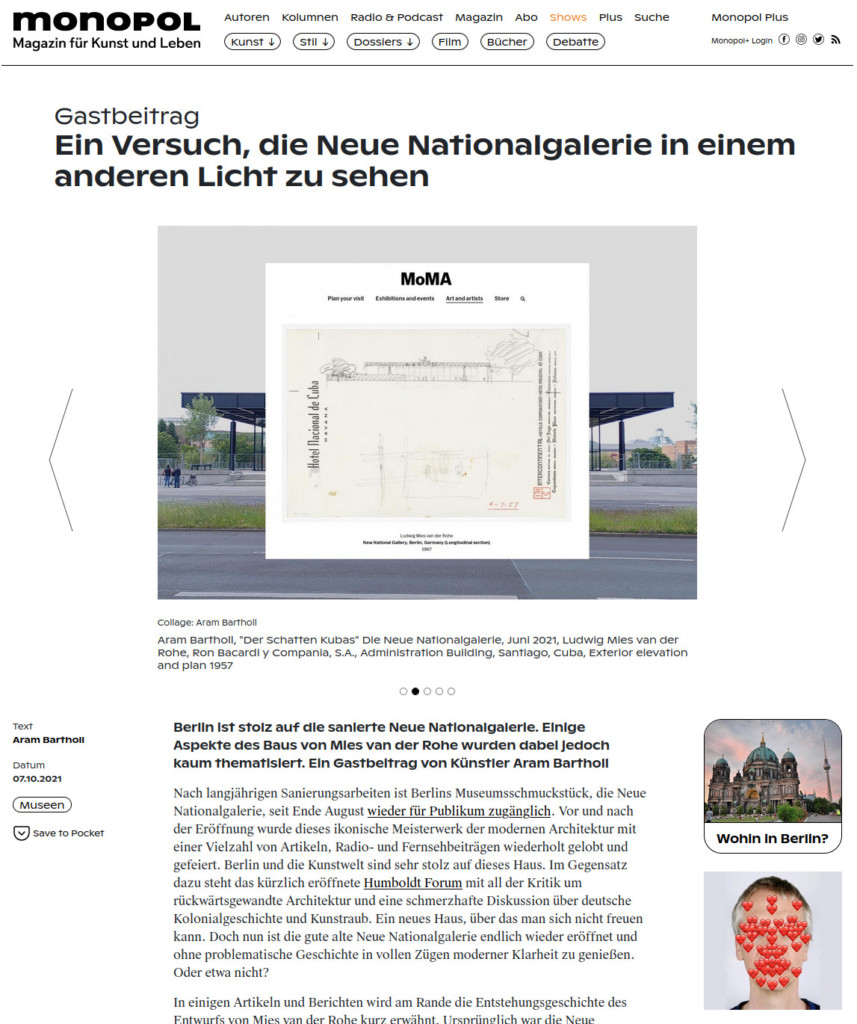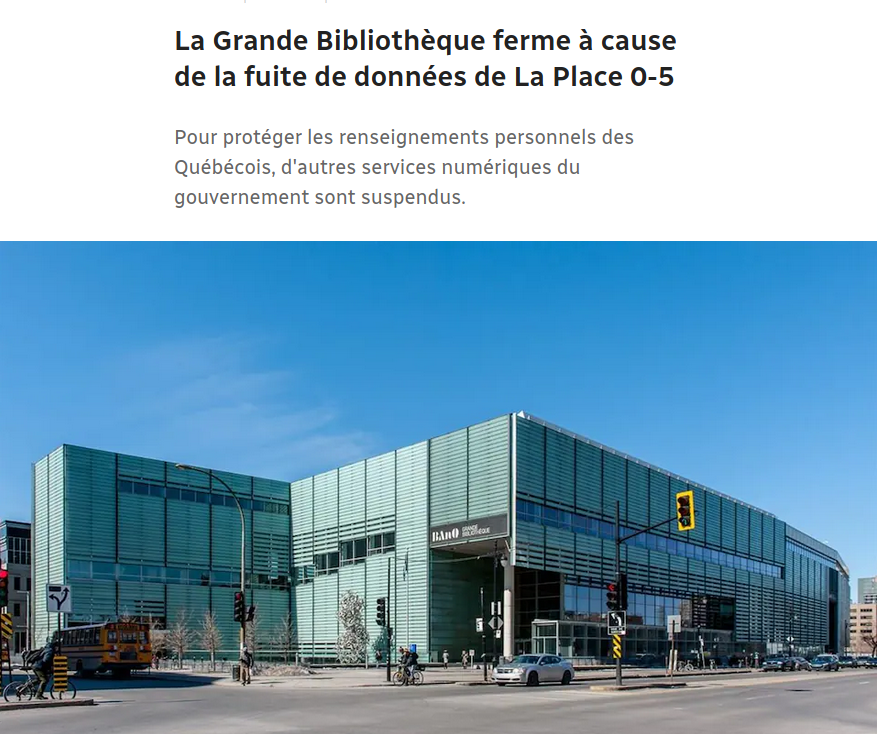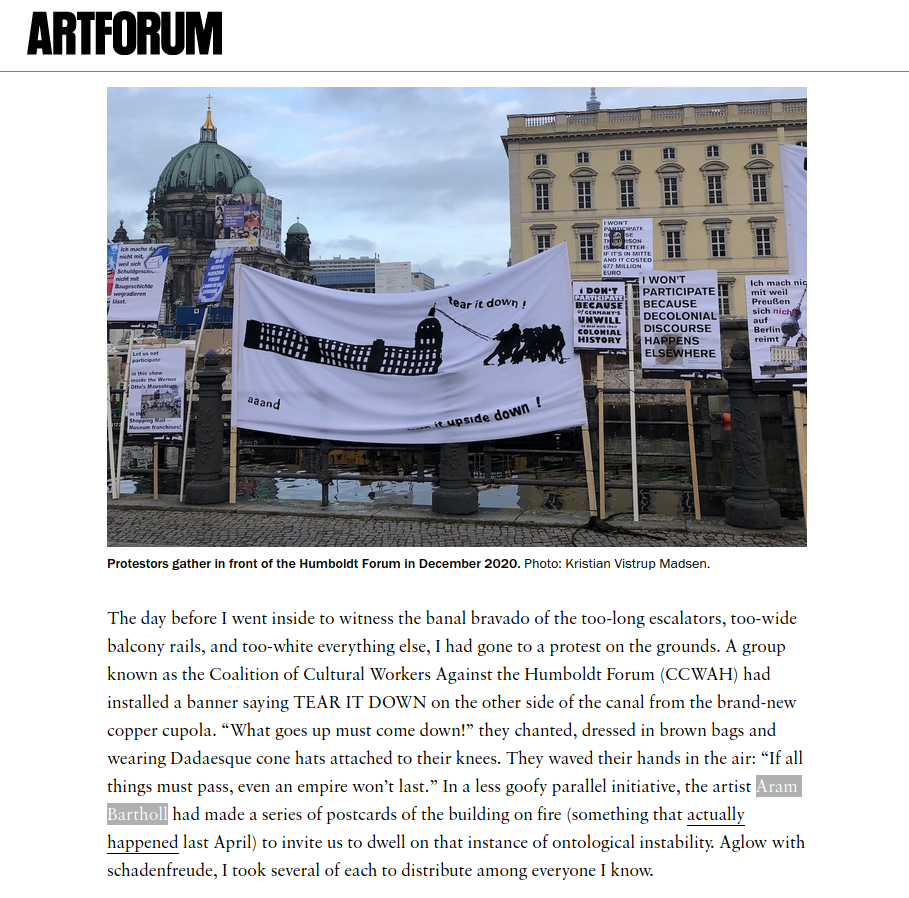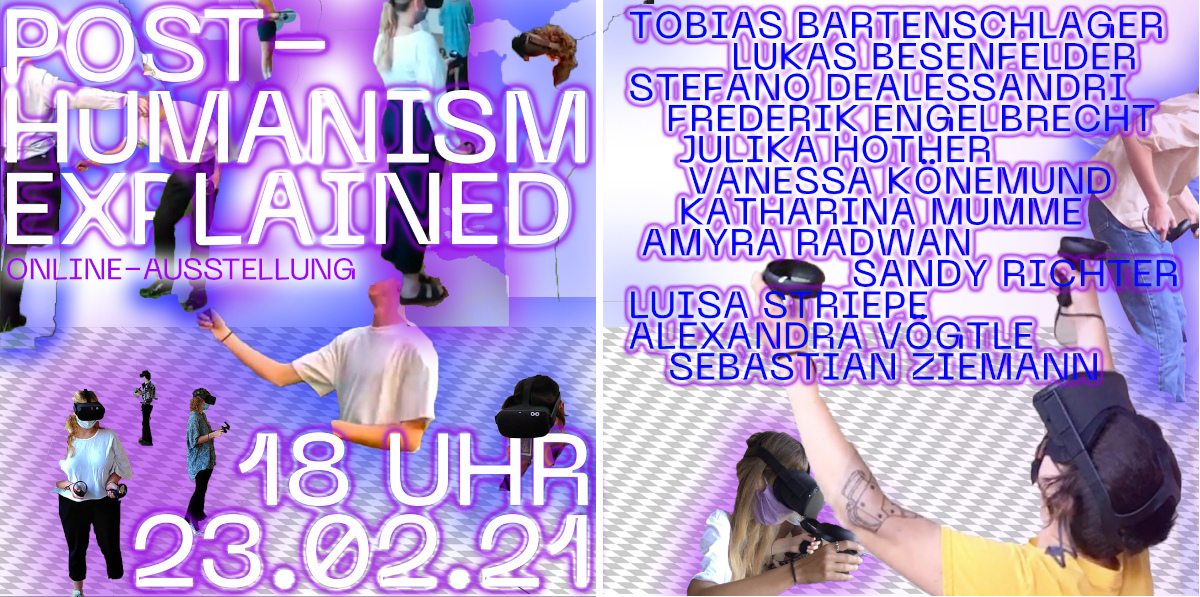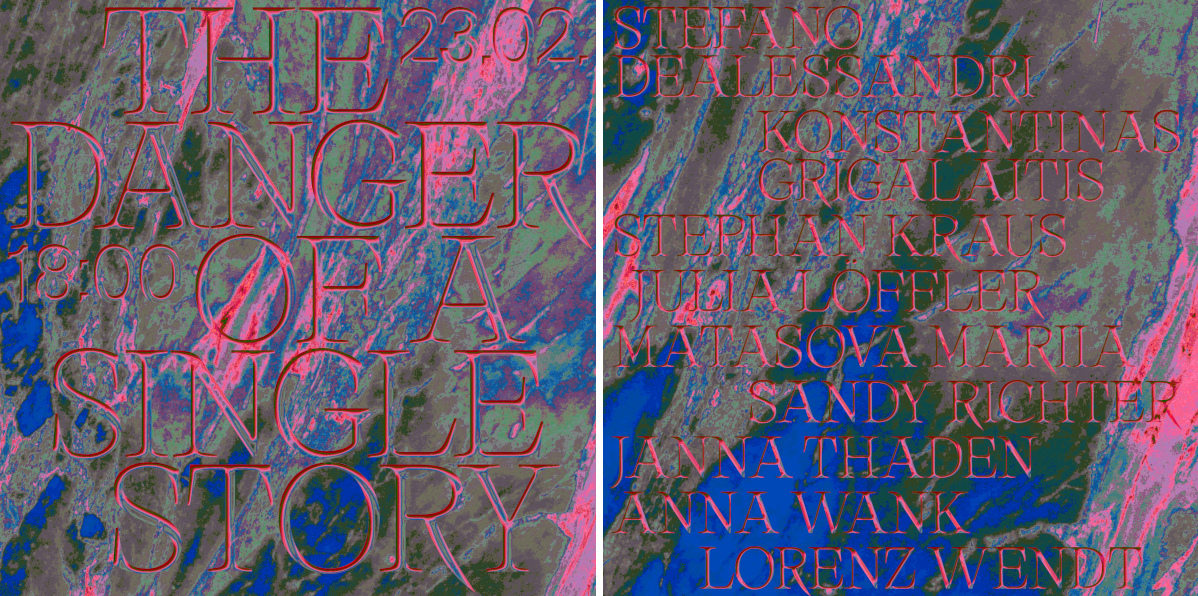Colonial Shadows – Neue Nationalgalerie Berlin
[This article was published first in German in monopol magazin October 2021]

(photo: Aram Bartholl 2021)
Attempting to see the Neue Nationalgalerie in a different light
Berlin takes great pride in the newly renovated Neue Nationalgalerie but some aspects of Mies van der Rohe’s iconic building have been barely addressed. Guest contribution by artist Aram Bartholl.
After many years of renovation works, the jewel of Berlin’s museums, the Neue Nationalgalerie, was opened to the public once again at the end of August. Prior to and since its opening, this iconic piece of modern architecture has been repeatedly celebrated and praised with a multitude of print, radio, and television features. Berlin, and the art world, take so much pride in this building. In stark contrast is the recently opened Humboldt Forum, criticized for it backward-looking architecture and the accompanying painful discussions of German colonial history and art theft. A new building that cannot be celebrated but now the good old Neue Nationalgalerie has finally reopened without any problematic history, its modernist clarity can be enjoyed to the full. Or can it?
The genesis of Mies van der Rohe’s design is given a cursory mention in a few articles and reports. Plans of what would become the Neue Nationalgalerie were originally developed as the headquarters of spirits manufacturer Bacardi, which never was never realised, a detail one Deutschlandfunk presenter giggles about briefly before immediately gushing over the open floor plan and the building’s incredible transparency. But there is more to this story. How can a company headquarters turn into a museum? And why couldn’t the headquarters be built at the time? It is worth taking a look at the buiding’s history prior to it becoming the Neue Nationalgalerie.
Mies van der Rohe, former director of the Bauhaus, banned in Nazi Germany in the 1930s, stopped receiving commissions, so he emigrated to the US in 1938 to take up a professorship in Chicago. Recently, there has been renewed discussion about his relationship to National Socialism — it was said for years that van der Rohe was “apolitical.” His preference for glass and steel suit was a perfect fit for the high-tech building culture of the US and he rose to become one of the best-known architects in the country in a few short years. He was behind all of the iconic buildings that became modern architectural classics.
One of those is the famous Seagram building in New York, designed as Seagram Distillery’s headquarters and completed in 1958. Constructed from the highest quality materials, the skyscraper was a complete success and became a flagship for the Canadian distillery company. Competition was not far away. Bacardi, another successful distillery, wanted its own building designed by a star architect to promote the company. But not in New York — Bacardi was originally headquartered in Cuba.
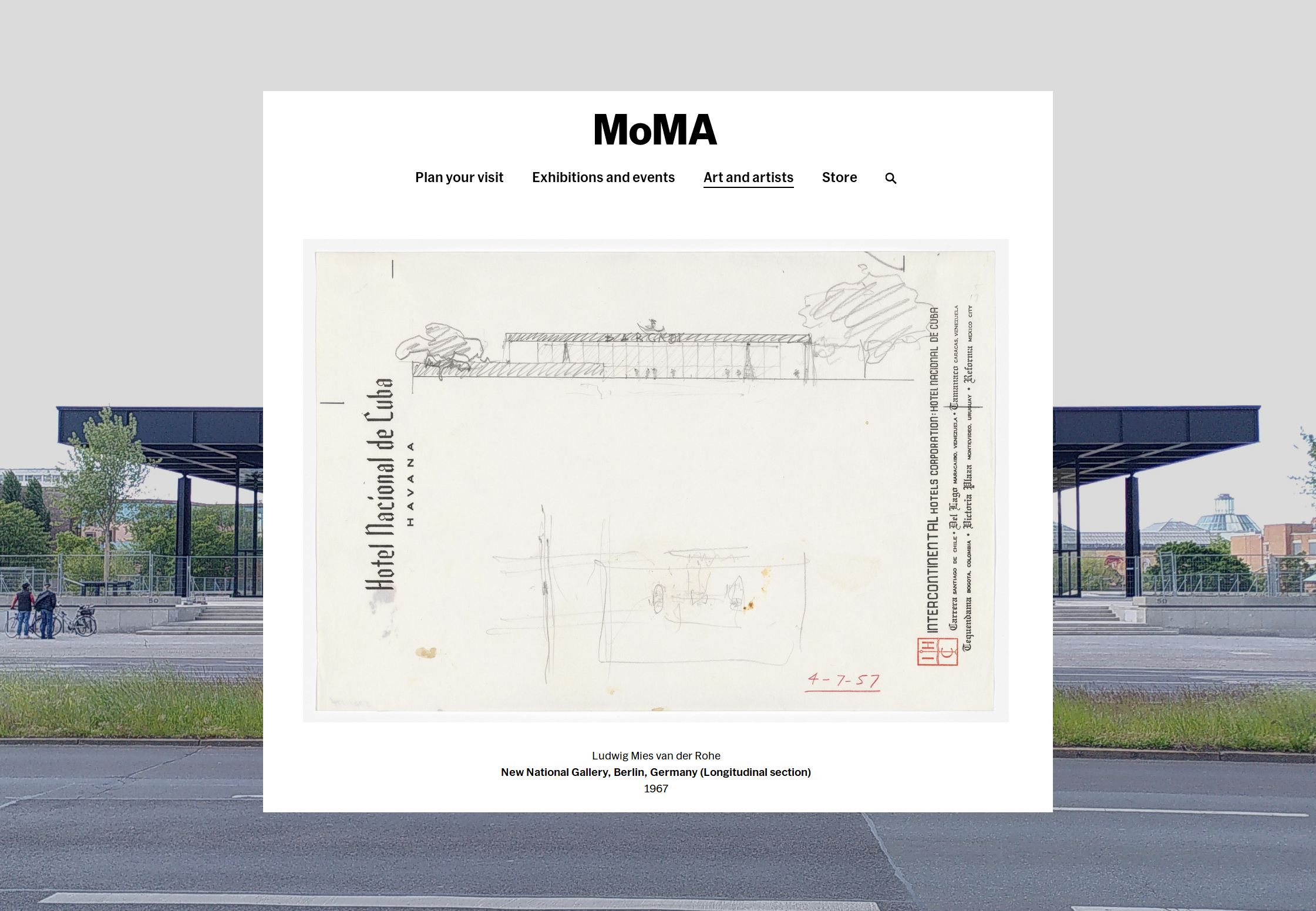
Collage: Neue Nationalgalerie and original design sketch by Mies van der Rohe, 1957 (screenshot: MoMA collection website)
An administration building for Bacardi
In 1957, Mies van der Rohe was already on his way to Havana, were he sketched his first ideas for an administrative building on a cocktail napkin in the presence of Bacardi’s president, Jose Bosch. Though the Bacardi logo is featured, what would later become the Neue Nationalgalerie can already be recognised clearly in the sketch. Fun fact: van der Rohe misspellt “Bacardi.” The famous napkin with the first sketch of the building is now held in the MoMA collection.
Two years later, in January 1959, he presented the finished design of the building, a somewhat smaller version of the Neue Nationalgalerie, at the Hilton Hotel Havana. But that same month the political situation in crisis-ridden Cuba fundamentally changed. The communist revolution, led by Fidel Castro drove out despised President Batista and put an end to the military dictatorship. All the large landholdings and big companies were expropriated. As a result, the Bacardi family business fled abroad, and the administration building project fell apart from one day to the next.
It isn’t unusual for an art or architecture project to not work out for whatever reason, and it may be that it is realised later elsewhere. It doesn’t mean that the quality of the project suffers. It may even improve. In the case of the Nueu Nationalgalerie, however, it is interesting to take a closer look at the context of the initial planning of the building — both the function and the location of the building change radically in the eventual realisation. A closer look at the history of Cuba is pertinent here.

Collage: Neue Nationalgalerie, evolution of the design (video still: „Die Neue Nationalgalerie“, ein Film von Ina Weisse. 2017)
Cuba’s history is marked by many years of colonial exploitation, as are so many parts of Latin America. For centuries, Cuba was a colony of the Spanish crown, which made a fortune on the back of sugarcane cultivation on a massive scale. The “white gold” business was extremely lucrative, though profits came at the expense of generations of enslaved people who were brutally exploited — forced to work under inhumane conditions on the sugar plantations at the hands of Spanish colonists.
Cuba was the largest producer of sugar in the world for a very long time, meeting up to a third of Europe’s ever-growing demand for sugar. Molasses, a bypoduct of sugar cane processing, was often used in distilleries to make rum, which in turn, was used as a means of payment in the African slave trade. Bacardi, a traditional company, was founded in Cuba towards the end of the colonial period.

Collage: Neue Nationalgalerie and „Cuban Sugar Mills in the 19th Century“ (photo: latinamericanstudies.org)
Cuba’s sugar cane industry and Neue Nationalgalerie
Bacardi was founded in 1861 by Don Facundo Bacardí Massó, who had emigrated from Spain to Cuba. He was successful in using new processes to distill “rough” rum, which was known as a distinctive and very shelf-stable drink popular with sailors, into a higher quality white (clear) rum. Cuba, with its centuries-old history of sugar production, was naturally the ideal place for Don Facundo to set up a distillery specialised in rum. The raw ingredient, molassess, was available in large quantities at very reasonable prices. Cuba did not enact a complete ban on human trafficking until 1886, twenty years after the US and two years earlier than Brazil. The rest of Bacardi’s history is story of complete success, particularly during prohibition – the US ban on alcohol (1920-23) – when the company enjoyed the same immense growth as competitor Seagram in Canada.
But what does all this have to do with the Neue Nationalgalerie? What is it that makes the building so special? Of course, the open floor plan and the full transparency of the glass hall are fascinating. Supported by only eight pillars, the incredible roof made of 1200 tonnes of steel, floats at a height of 8.4 metres and spans a huge area, completely unencumbered. The glass façade underneath is set very far back. The roof projects seven metres beyond the façade on every side. And this is where it gets interesting. Van der Rohe had, of course, worked with overhanging rooves on other buildings; the overhang emphasises the floating nature of the roof slab, hanging as though the glass façade did not even exist. But there is another important reason for this overhang. Cuba, located in the Caribbean, has a tropical climate. The sun shines mercilessly, and shade is a prized commodity, especially for a full-glazed building. The cantilevered roof was clearly designed for Cuba’s climatic condissions. A former employee of van der Rohe’s office had this to say:
“The intense tropical sun in Santiago prompted Mies and Summers to modify the familiar glass box form used in Crown Hall by designing the large roof that shaded the main volume. This broad overhanging roof would become one of the signature elements of the New National Gallery, and although Mies had designed large overhangs before, the distinctive form it took in the late work emerged in the Bacardi project and was inspired in part by Cuban vernacular architecture. Summers recalled the development of the Santiago scheme: “… we were sitting under this overhang which was quite interesting, it was probably twenty feet high, it had long sort of colonial-like columns [with] probably twenty feet … between the column and the wall and we were sitting very comfortably on lounge chairs having a drink and I said to Mies, “this is kind of what we need to shelter the glass and to offer shadow and to keep the sun out of the inside. At least in the summertime.” (Kathryn E. O’Rourke (2012) Mies and Bacardi)

Collage: Neue Nationalgalerie and “Oak Alley Plantation“ Villa Louisiana USA, built in 1837. (Photo: Wikipedia)
Schinkel as a source of inspiration
We could now ask how the Neue Nationalgalerie would have even functioned as an administration building. The president of Bacardi wanted an open space for a trendy open-plan office. We can only speculate on the appropriateness of this large glass hall for such a purpose. It has always posed challenges when used as an exhibition space as well (for the Calder exhibition, the first thing put up was of course a huge white wall blocking the line of sight). It seems that the function of the building plays a subordinate role. Architectural historians all agree that van der Rohe’s ultra-modern designs refer to the architecture of ancient temples with his ultra-modern. The lower level of the museum, with its wide staircase, functions as a plinth, topped with a sublime columned temple of glass and steel.
Dirk Lohan, Mies van der Rohe’s grandson, has said that when his grandfather designed the Neue Nationalgalerie, he was clearly thinking of Schinkel’s Alte Museum. The fact that the original design had been intended for Cuba somehow didn’t seem to matter. Either way, Greek temples with their strict desing and construction rules, have always been an influence on architects, and naturally for Berlin master builder Schinkel. Plantation owners, however, liked to employ these same attributes to project a better image. A great example is “Oak Alley Plantation” Villa, built in Louisiana, in the southern US, in 1837. It is completely symmetrical, and its columns also holding up a wrap-around, shaded veranda. At that time, and even now, such references serve to show off perceived superiority and “gentlemanliness.”
You could be forgiven for mistaing the Bacardi design for a large, plantation owner’s villa rather than for an office building. The musem’s sculpture garden, enclosed by high walls, recalls the sheltered interior gardens found in stately homes in Cuba.
In short: next time you go to the Neue Nationalgalerie, check out the wide, overhanging roof and think about the building’s history. It had its beginnings with German architect, a luminary of modernism who had to shut down the Bauhaus, and who then became a member of the Reich Chamber of Culture before emigrating to the US. While there, he designed a temple for a globally operating company in crisis-ridden Cuba.
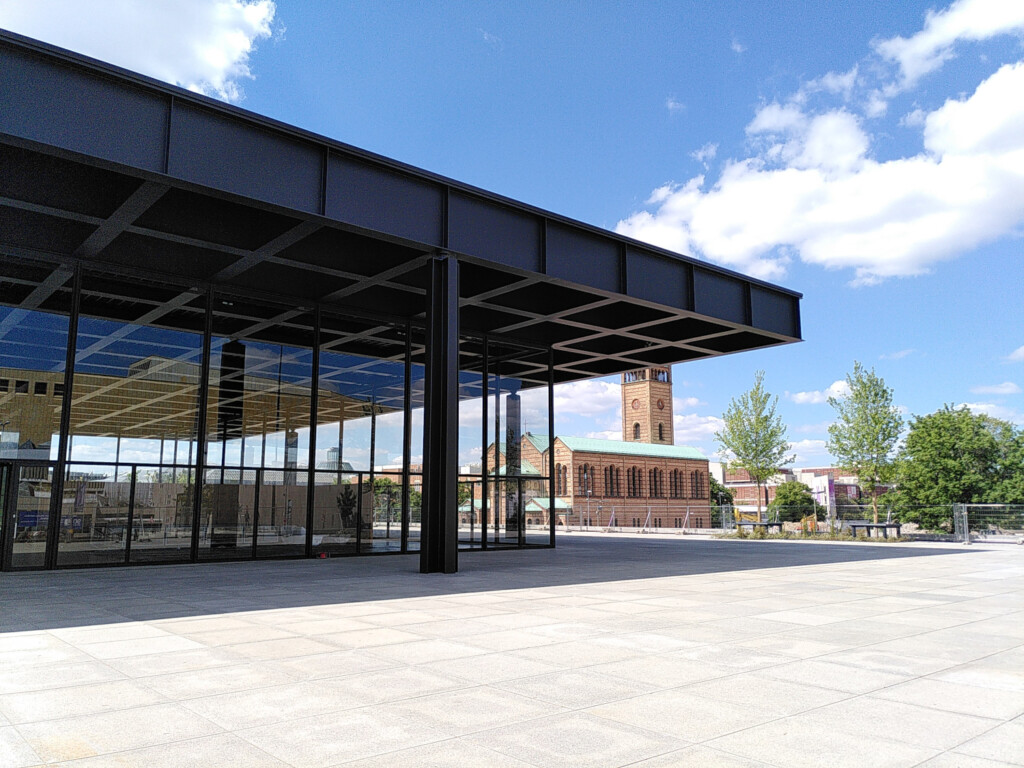
Neue Nationalgalerie as of today after renovations in summer 2021. (photo:Aram Bartholl)
Tropical Climate in Berlin
Like many other companies, Bacardi owed its success to the long and extremely brutal colonial history Europe imposed on the world. The island of Cuba is marked by a history of exploitation and military dictatorship. Work on “Villa Bacardi” was interrupted by the Cuban Revolution, but the design reappeared later as the Neue Nationalgalerie in cold Berlin.
And the irony of the story? The Neue Nationalgalerie stands on the exact spot that Hitler and his architect Albert Speer had earmarked for the House of Tourism, as part of the huge north-south axis planned for the capital of the Thousand Year Reich.
It’s not that cold in Berlin, not in the summer anyway, and the glass facades need shadows too. And so it is fortunate that when, in the not too distant future, Berlin will have a more tropical climate, this building, with its almost “proxy colonial history,” will already be on the right spot. When you stand there, in the shade of the 1200 tonne roof, think about the sugar cane fields of Cuba, and sugar cane, the same as what Chrosotpher Columbus brought back from the Carribean 500 years earler.
Aram Bartholl 2021
[This article was published first in German in monopol magazin October 2021]




